Thailand ranks among the top ten fishing nations of the world
with marine products accounting for more than 90% of the annual
production. Molluscs account for a modest percentage of this
production, however there is great potential for expansion, and
the Government of Thailand, through the Department of Fisheries
(DOF) is emphasizing coastal aquaculture development especially
with regard to bivalve culture. This development activity is the
responsibility of the Brackishwater Fisheries Division (BFD) of
the DOF, which is assisted by several agencies including the Food
and Agriculture Organization of the United Nations (FAO), the UN
Development Programme (UNDP), the Japan International Cooperation
Agency (JICA), the Asian Development Bank (ADB), and the World
Bank.
Up to about 50 years ago Thailand had abundant resources of
oyster from natural beds. These resources have gradually
decreased due to over-exploitation and pollution brought about by
a substantial population increase in coastal communities. To
meet the growing demand for oysters in the country as well as to
exploit foreign markets, oyster culture was first initiated in
Chonburi, Rayong and Chanthaburi Provinces, later spreading to
the southern part of Thailand (Prachuab Khirikhan, Surat Thani,
Songkhla and Pattani Provinces).
Three commercially important species are captured from natural
beds and cultured: Saccostrea commercialis, Crassostrea lugubris
and Crassostrea belcheri. The first, a small species, is
commonly cultured along the east coast of the Siam Gulf. The
latter two larger species are produced naturally and cultured
mainly on the west coast of the Siam Gulf and on the west coast
of Thailand (Table 11 and Fig 24). They obtain a higher market
value than S. commercialis mainly because they are consumed
fresh.
Oyster production figures from 1980 to 1985 are shown in Figure
25. Although the production for 1985 (8,757 MT) was lower than
in previous years (possibly due to the limited supply of seed)
the output from 1980 to 1984 had steadily increased with an
annual growth of 20.5 %. The total area under oyster
cultivation is reported to be just under 1,000 hectares.
Sites for oyster culture are usually on the hard, stable bottom
of intertidal flats which support heavy collectors for spat
attachment and growth. However, a variety of coastal
environments have been explored.
Various culture methods are practised in Thailand. The most
suitable for a given area depends on factors which are site
specific, the most important being bottom and sea conditions.
Oysters can be grown in three basic ways : bottom, suspension,
and midwater culture. All these techniques are currently being
practised in Thailand and for each type a number of different
methods have developed.
Rock culture. This method is unique to Southeast Asia. It is based on the use of natural rocks as a substrate for spat settlement and growth until harvest. The rocks are usually piled in groups of 5–10 and spread in rows approximately 50 cm apart in each direction so as to facilitate management and harvest. This technique is used in areas with hard, sandy or sandy-mud bottoms firm enough to support the rocks. Bamboo mats or platforms are commonly used in soft bottom areas to prevent the rocks from sinking.
Tray culture. This technique is usually practised in muddy bottom areas. Trays are usually built in any convenient size; there are no standard sizes but a popular dimension is 100 x 80 cm with a height of 25 cm. Trays, which are mounted on stakes approximately 30 cm above the bottom, are constructed from strong wood (bamboos are often used) and are fitted with a nylon net bottom. Oysters used for tray ongrowing are removed from rocks or other spatted materials at 2 cm in length.
Culture on cement poles. This method is suitable for muddy substrates. Its advantages are its durability and resistance to wind and wave action. The cement poles (Fig. 26) which are manufactured by the fishermen constitute two separate units: 1) a supporting pole roughly one meter in length (sometimes substituted with wood poles) (Plate 8) and 2) a concrete “cap” 50 to 70 cm in length (Plate 9) on which the young spats (2 to 4 cm in diameter) are fixed with cement. The concrete support pole is buried in the sediment as deep as half of its length, depending on bottom conditions. The cap, which has an opening for insertion in the pole, is then fixed over the top of the previously buried pole (Plate 10).
Culture on wooden poles. This technique is suitable for areas with strong but not destructive currents and wave action. Poles are set in soft or muddy bottoms similar to the system used for green mussel culture. Some producers allow spat to settle on the poles and use the initial spat set for grow out to market size; others purchase spat and mechanically fix them on the poles. Low-priced locally available bamboo or wood is used. Poles are firmly driven into the bottom at a depth that depends on the sediment composition. One disadvantage is the brief life of the poles (about one to one-and-a-half years).
Culture on cement pipes. This system is similar to cement post culture. However, the pipes can be acquired from local dealers and do not have to be especially manufactured for oyster culture. The pipes are fitted on strong wooden or concrete stakes driven into the bottom of the culture area Plate 11 and Plate 12).
Suspension culture. Suspension or hanging culture is widely practised in Japan, United States and Europe because the oysters grow fast and give high yields. This method has been tested in Thailand but, although good growth was observed, a number of problems were encountered, mainly with regard to material durability and the relatively high initial investment as compared to other types of culture materials. This method however, would be most suitable for sheltered deep waters.
Oyster spat collection uses all kinds of materials on which the
oyster larvae will attach. However, not every material is
suitable as cultch from the practical and economic points of
view. Shells of Placuna placenta are commonly used and
experiments are being carried out to determine whether cement
coated shells or plain shells are more suitable (Plate 13 and
Plate 14). It is reported that spatting of oyster occurs in two
seasons during the year, in May to July and in October to
November. Oyster farmers need a simple way to determine the best
time to place the collectors, avoiding attachment of fouling
organisms and maximizing spat collection. As suggested by BFD,
farmers should place a few collectors several months before the
spatting seasons, monitoring them for occurrence of oyster spat.
When suitable numbers of spat are found on the test collectors,
the bulk of the collectors can be placed. Oyster farmers have on
the average, 7 rai (11200 m2) and usually hire one or two
permanent workers who perform a number of duties ranging from
spat collection to harvest. Temporary labour is necessary during
peak harvesting periods when market size oysters have to be
removed piece by piece. An average of 2.0 × 103 kg/rai (19t/ha)
is removed annually.
Molluscs are sold either fresh or cooked. S. commercialis are
usually shucked and frozen so as to exploit distant markets. C.
lugubris and C. belcheri are commonly sold shell-on for
consumption. At present there is little health control because
molluscs are not dangerously affected by pollutants. However,
with the increase in industrial activities, monitoring flesh
quality will be essential. Fishermen remain interested in oyster
culture as supply does not meet demand.
The constraints to oyster culture in Thailand are mainly limited
seed supply, especially of C. belcheri, limited suitable culture
areas and poor quality control.
Environmental problems (coastal pollution) are limited mainly to
the production areas in the inner Gulf of Thailand where 70 % of
the coastal aquaculture production is derived. Pollution in the
Gulf is generally the result of a major conflict in the use of
the coastal zone. Industrial plants release materials that are
detrimental to aquaculture production such as pesticides,
herbicides, heavy metals and fertilizers. Problems of low oxygen
content in the water caused by the decomposition of organic
matter are becoming chronically serious in the inner part of the
Gulf and in the estuaries of main rivers. The “red tide” is
increasingly a threatening problem as it is also associated with
the nutrient richness and organic waste materials in the sea.
Thailand is expanding considerably and projects are underway to
introduce oysters culture in different parts of the country. At
the moment oyster spats are harvested naturally from the sea,
however, the recently built bivalve hatchery at the Prachuab
Khirikhan Brackishwater Fisheries Station is producing oysters
which are utilized for a number of demonstration and on-growing
trials.
On average 2 million oyster spat size 2 mm are produced monthly,
but only a small percentage (5 %) reaches 3 cm which is the size
preferred by the fishermen. More research is required to improve
survival of young spat, and efficient nursery practices need to
be introduced, developed and tested to reduce spat production
costs. Various experiments are now underway at the hatchery.
For many reasons capture fisheries is becoming less feasible, and
as a consequence, coastal aquaculture is receiving a great deal
of attention. Mollusc culture is one sector that is rapidly
developing. Traditional culture methods are being improved
through the introduction of techniques from technologically
advanced countries. However, one major factor which will
influence the expansion of this activity is the ecology of the
coastal areas where mollusc culture is mainly practised. More
and more areas are becoming dangerously polluted by industrial
and domestic wastes and therefore, in addition to farm
management, careful monitoring will be required to maintain
healthy environmental conditions.
Although at present depuration of shellfish is not practised in
Thailand, the DOF is conducting experiments on technical and
economically feasible depuration systems.
Table 11. Distribution and main culture areas of commercially important oyster species in Thailand.
| SPECIES | PROVINCE | LOCALITY | NOTES |
| Crassostrea belcheri | Rayong | -- | Natural beds and some culture activities. |
| Chumphon | -- | Natural beds and some culture activities. | |
| Ranong | -- | Natural beds and some culture activities. | |
| Surat Thani | -- | Natural beds and extensive culture activities. | |
| Phangnga | -- | Natural beds and some culture activities. | |
| Trang | -- | Natural beds and some culture activities. | |
| Satun | -- | Natural beds and some culture activities. | |
| Crassostrea luqubris | Songkhla | -- | Natural beds and some culture activities. |
| Pattani | -- | Natural beds and some culture activities. | |
| Phangnga | -- | Natural beds and some culture activities. | |
| Saccostrea commercialis | Chantchaburi | -- | Natural beds and medium scale culture activities. |
| Rayong | -- | Natural beds and medium scale culture activities. | |
| Chonburi | -- | Natural beds and extensive culture activities. | |
| Prachuab Khiri Khan | -- | Natural beds and small scale culture activities. | |
| Chumphon | -- | Natural beds and some culture activities. | |
| Krabi | -- | Natural beds and some culture activities. | |
| Trang | -- | Natural beds and some culture activities. | |
| Satun | -- | Natural beds and some culture activities. |
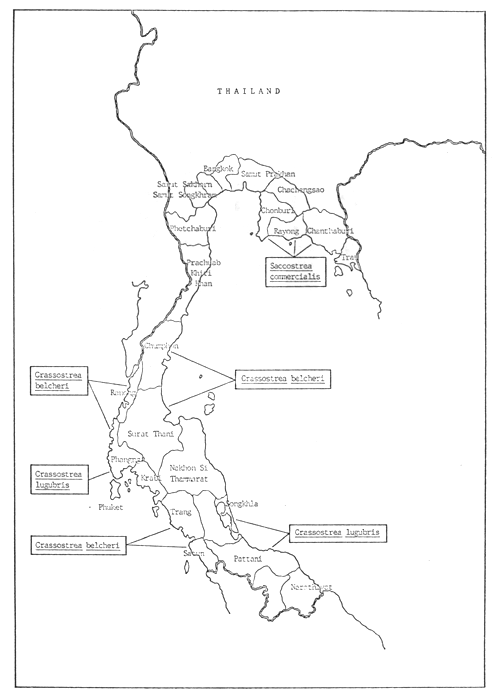
Figure 24: Major farming areas of the three commercially important oyster species in Thailand.

Figure 25: Oyster production data in Thailand from 1980 to 1985.

Figure 26: Cement pole (a) for oyster culture as practiced in Thailand;
cement pole (b) with attached adult oysters.
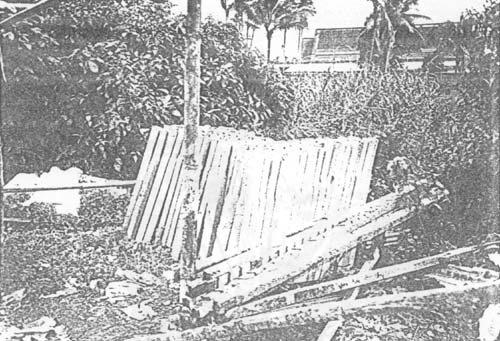
Plate 8: Cement pole culture. Cement cap supporting pole, Ranong, Thailand.
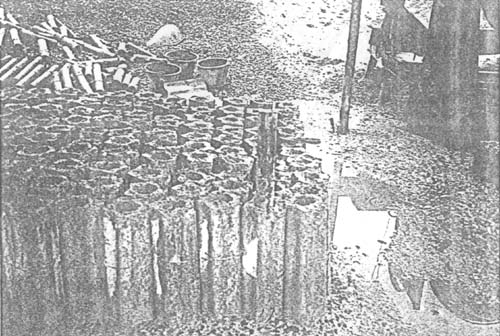
Plate 9: Cement pole culture. Manufacturing site of the cement caps, Ranong, Thailand.

Plate 10: Harvesting of marketable size oysters cultured by the cement pole method, Surat Thani, Thailand.
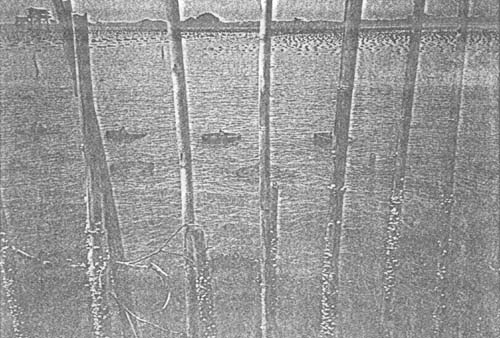
Plate 11: Cement pipe culture, Surat Thani, Thailand.

Plate 12: Cement pipe culture. The bamboo fence defines individual private farms. Small guard-houses are visible in the background.
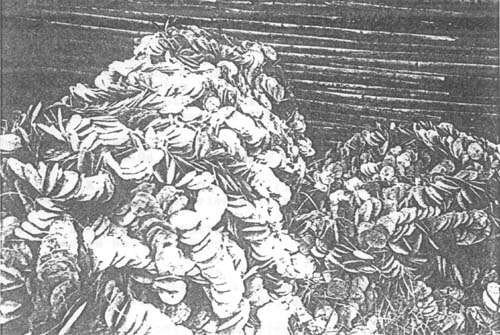
Plate 13: Plain (left) and cement-coated (right) windowpane shells (Placuna placenta) used as oyster spat collectors, Phangnga, Thailand.
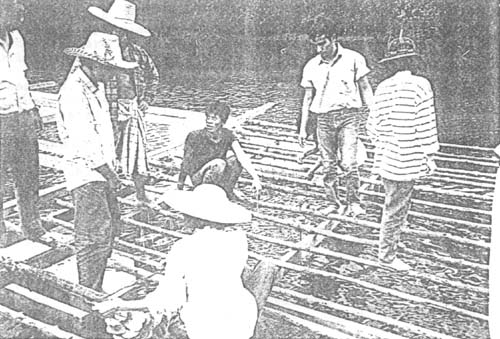
Plate 14: Fixing of windowpane oyster spat collectors on a raft, Phangnga, Thailand.